Keep it interesting: 3 ways to mix up your squats.
Bored of barbell squats? Want to minimise injury risk, but still progressively overload your squat? Try these three barbell squat alternatives in your workout routine.

Squats are a fantastic exercise for muscle and joint strength because they use so many different muscle groups. Squats are considered to be a fundamental movement pattern and are compound exercises, meaning that the traditional squat is an extremely important movement pattern in your everyday life. Sitting down and standing up from a chair, picking heavy things from the floor, and lifting children all utilise the basic squatting technique, which is one of the reasons exercise professionals prescribe squats in their workout plans.
Barbell squats are typically one of the most prolific squatting exercises prescribed in workout plans - this is because they are easy to regress and progress (i.e., reducing or increasing the weight on the barbell), and relatively quite easy to get the hang of. However, barbell squatting week-in-week-out can become tiresome and lead to workout boredom, especially for the general individual (as opposed to a powerlifter for example). Unfortunately, the progression ceiling (i.e., how much you can load onto the bar) also rears it's head quite quickly for barbell squatting and this too can lead to workout boredom as well as being disheartening.
The progressing ceiling of barbell squats can be reached quite quickly, as once the general individual passes around 100-150kg (dependent on weight, sex, height, mechanics etc), it can be very difficult to squat heavier weight without injury.
Changing up your squat is important.
Squat Alternative 1: The Goblet Squat
Our first squat alternative is the Goblet Squat. A goblet squat is when you hold the weight in front of your body. We typically use kettlebells or dumbbells for goblet squats.

Goblet squats are great for focusing more tension on the quadricep muscles. With a goblet squat, we shift our body backwards slightly to accommodate for the weight we are holding in front of us, and thus this shifts the load from glutes to mostly quadriceps. This exercise is excellent as it is so closely related to how we naturally lift things - that is, we normally lift heavy weights in front of us as opposed to behind us like with a barbell squat. With a goblet squat, you can also raise your heels (for example, having your heels on a bumper plate) to focus even more tension through the quadriceps.
Note: Generally, with goblet squats you are limited by the amount of weight you can hold with your hands and therefore may not be able to lift as much as a barbell squat. This is normal and you can increase the reps to increase difficulty.
Example workout with Goblet Squats
- Warm up: 5-10 minutes on treadmill at medium speed
- Conventional deadlift: 4 x 5
- Goblet squat: 5 x 10
- Dumbbell RDL: 4 x 8
- Bodyweight Bulgarian split squats: 3 x 10
- Box jumps: 4 x 10
- Cool down: Light stretching
Squat Alternative 2: Squat Jumps
The second squat alternative is Squat Jumps. This exercise uses the classic squat form, but adds in a high intensity power element: the jump. Don't under-estimate the difficulty of this exercise, it is much more intense than it looks.

Squat jumps are a great way to increase difficulty and progressively overload your regular squat, especially if you have no equipment. The power aspect of the squat jump (i.e., the jump portion) not only utilises more aerobic capacity but also requires much more effort from your quadriceps for pushing off portion of the jump. The dynamic aspect of the squat jump also requires more neural drive and effort to re-stabilise you when you land, which also increases the intensity.
We often prescribe squat jumps at the end of a workout because it's relatively safe and we want to fatigue the muscles as much as possible before high power exercises like a squat jump. This gives us the best opportunity for progressively overloading.
Example workout with Squat Jumps
- Warm up: 5 - 10 minutes of skipping/jump rope
- Chin ups: 3 x 10 (assisted or not assisted)
- Overhead press: 4 x 10
- Dumbbell snatch: 3 x 12
- Walking lunges: 4 x 10
- Box jumps: 3 x 12
- Squat Jumps: 3 x 10
- Cool down: Light treadmill walk
Alternative 3: Box Squats
Our final alternative is box squats. Don't be dismissive of the simple box squat - it is a fantastic exercise for all fitness levels whether you can easily squat 100kgs or none at all.

Box squats for beginners: Box squats are the best way to learn how to barbell squat without a coach or if learning alone. It is extremely safe and allows you limit the risk of injury. The hardest part of a regular squat is at the bottom (when you're as far down as you can go) and that is when you need the most strength recruitment to push back up to standing. The box squat removes that portion of the squat, reducing injury and allowing the individual to get a feel for the exercise. A higher box is easier, with a lower box being harder. This can be done with or without a barbell.
Box squats for non-beginners: Box squats are a great way to safely, progressively overload your barbell squat and assess your strength before you go for the squat. If you feel you can confidently do the box squat at your preferred weight, moving on to the unassisted squat is the next progression. You can also use the box squat to find any 'sticking points' or points that are uncomfortable highlighting any rehabilitation you may need to do.
Example workout with Box Squats
- Warm up: 5 - 10 minutes on the rowing machine
- Box squats: 3 x 5 at a heavy weight
- Barbell squat: 3 x 5 at comfortable weight
- Dumbbell lunges: 3 x 10
- Hip extension machine: 4 x 12
- Calf raises: 4 x 10
- Cool down: light yoga stretches
Don't forget to have fun and enjoy your workouts! Use these ideas to help guide your next workout, reduce injury risk, and help to manage muscle imbalances.
Follow us on twitter:
Wall Pilates? A fitness trend that provides minor-to-no strength, hypertrophic or cardiovascular improvements. For the general population, let's focus on high yield exercise modes that are science-backed and efficient. https://t.co/az6EHWfVqn pic.twitter.com/pJU6FHMEHu
— TheExerscientist (@exerscientistau) September 22, 2023

